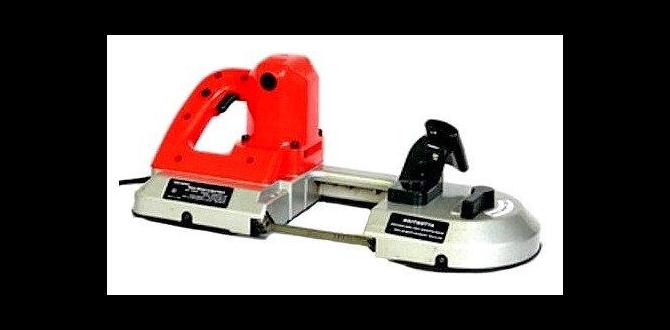Have you ever finished a project and wondered how to store your nailer properly? If you’re a beginner, it can be confusing. You want to keep your tools safe and working well. What if you could learn some easy tips to do this right?
Picture this: it’s a sunny weekend, and you finish a fun DIY project. You’re proud of your work, but now you face a new question. Where do you put your nailer? If you store it poorly, it might get damaged.
Storing your nailer can be simple. Yet, many people don’t know how to do it. Did you know that keeping your nailer clean helps it last much longer? It’s true! In this article, we’ll share some helpful tips on how to store your nailer properly. You’ll learn how to protect your tools and keep them ready for your next big project.
Table of Contents
How To Store Your Nailer Properly For Beginners: Tips And Techniques Storing Your Nailer Properly Is Essential For Maintaining Its Performance And Longevity. As A Beginner, You Might Be Unsure About How To Do It Effectively. This Article Provides Clear Guidelines On The Best Practices For Storing Your Nailer. Proper Storage Not Only Protects The Tool But Also Ensures Safety And Readiness For Your Next Project. Here’S What You Need To Know. 1. Clean Your Nailer Before Storage Before Storing Your Nailer, It’S Crucial To Clean It Thoroughly. Remove Any Dust, Debris, Or Leftover Nails. Use A Soft Cloth And A Mild Cleaner Suitable For Your Tool’S Material To Avoid Damage. Regular Cleaning Prevents Corrosion And Ensures Smooth Operation When You Take It Out For Use Again. 2. Release Pressure In The Tool Make Sure To Release Any Air Pressure Before Storing Your Nailer. This Step Is Important As It Prevents Accidental Firing And Keeps The Tool In Good Working Condition. Follow The Manufacturer’S Instructions On How To Safely Release Pressure. 3. Store In A Cool, Dry Place Choose A Storage Location That Is Cool And Dry. Avoid Areas That Are Exposed To Extreme Temperatures Or Humidity, As These Conditions Can Damage The Internal Components Of Your Nailer. A Cabinet Or Toolbox Is Often Ideal For Storing Your Tool Away From Harsh Elements. 4. Use A Protective Case If Your Nailer Didn’T Come With A Protective Case, Consider Investing In One. A Durable Case Will Shield The Tool From Dust, Moisture, And Physical Damage. It Also Makes It Easy To Transport Your Nailer Safely To Different Job Sites. 5. Keep The Cord And Hose Organized If You Use A Corded Or Pneumatic Nailer, Make Sure To Organize The Cords And Hoses. Avoid Coiling Them Tightly, As This Can Lead To Damage Over Time. Use Ties Or Sleeves To Keep Them Organized And Ensure They Are Stored Neatly Alongside The Tool. 6. Regular Maintenance In Addition To Proper Storage, Regular Maintenance Is Key To Ensuring Your Nailer Lasts. This Includes Lubricating Moving Parts, Checking Seals, And Replacing Worn Components. Following A Maintenance Schedule Can Prevent Issues And Extend The Lifespan Of Your Tool. Conclusion By Following These Simple Steps On How To Store Your Nailer Properly, You Can Keep Your Tool In Excellent Condition And Ready For Any Project. As A Beginner, Understanding The Importance Of Proper Storage Will Set The Foundation For Successful And Safe Nailer Usage In The Future.

How to Store Your Nailer Properly for Beginners
Storing your nailer correctly helps it last longer and work better. First, always empty the nailer of any leftover nails. This prevents jams later. Next, clean the nailer to remove dust and sticky residue. Keep it in a dry and cool place to avoid rust. Using a protective case can also help. Did you know that improper storage can decrease your nailer’s performance? By following these simple steps, you can ensure your tool is ready whenever you need it.
Understanding Your Nailer
Different types of nailers and their uses. Importance of proper storage for longevity and performance.
Different types of nailers exist for various projects. For example, a brad nailer is great for light tasks like attaching trim. A finishing nailer works well for heavier jobs. Proper storage of your nailer helps it last longer and work better. Keep it clean and in a dry place. This keeps rust away and ensures it fires smoothly.
What are the benefits of proper nailer storage?
Proper storage helps nailers last longer and perform better. Regular maintenance also prevents issues that can arise from dust or moisture.
Key Storage Tips:
- Clean before storing.
- Keep in a dry place.
- Store upright if possible.
Why Proper Storage is Essential
Impact of environmental factors on nailers. Risks of improper storage: rust, damage, and malfunction.
Keeping your nailer safe is super important! Environmental factors like humidity and temperature can be big trouble. If it’s too wet or hot, rust can sneak in, turning your handy tool into a rusty pancake. Improper storage leads to serious issues like malfunction and damage, which is no fun at all. Remember, a well-stored nailer means fewer headaches!
| Environmental Factor | Risk |
|---|---|
| High Humidity | Rust |
| Extreme Heat | Malfunction |
| Cold Temperatures | Damage |
So let’s keep that nailer happy, and it’ll be happy to work for you!
Preparing Your Nailer for Storage
Cleaning your nailer: tools and techniques. Removing nails and cartridges safely.
Before storing your nailer, give it a good cleaning. Dust and grime can make it grumpy. Use a soft brush and a cloth to wipe it down. For tough spots, a bit of soapy water does wonders, just remember to keep it away from electrical parts. Once it sparkles, it’s time to remove the nails and cartridges. Always be careful! Point the nailer away from yourself and push the release button. Then, gently pull them out like you’re saving a kitten from a tree.
| Step | Action |
|---|---|
| 1 | Clean with a brush and cloth |
| 2 | Use soapy water for tough spots |
| 3 | Point away, push the release button |
| 4 | Gently pull out nails and cartridges |
Best Storage Locations
Ideal indoor spots: climate considerations. Outdoor storage solutions: ensuring protection from elements.
Finding the right spot to store your nailer is key to keeping it safe and working well. Indoors, aim for a cool, dry place like a basement or closet. Too much heat can cause it to overheat, while damp spots can lead to rust. Outside storage? Make sure it’s sheltered from rain and sun. Think of a sturdy shed or a covered porch—like a cozy vacation for your nailer!
| Storage Area | Climate Considerations |
|---|---|
| Indoor | Cool and dry is best! |
| Outdoor | Keep it covered from rain and sun. |
With proper care, your nailer will be ready to tackle any project, just like a superhero with a trusty sidekick!
Storage Materials and Equipment
Recommended storage containers: hard cases vs. soft cases. Using desiccants and moisture absorbers to protect against humidity.
Choosing the right storage container is key to keeping your nailer safe. Hard cases are sturdy superheroes, protecting your tool from bumps and drops. Soft cases? They’re lightweight sidekicks, perfect for easy carrying but not as protective. To fight humidity, consider using desiccants or moisture absorbers. Think of them as tiny sponges that soak up unwanted moisture. After all, no one wants their nailer to feel like it’s on vacation in a rainforest!
| Storage Type | Pros | Cons |
|---|---|---|
| Hard Case | Strong and protective | Heavier to carry |
| Soft Case | Lightweight and portable | Less protective |
So, whether it’s a hard shell or a soft cuddle, choose what best fits your needs. Happy storing!
Maintenance During Storage
Regular checks: what to inspect and how often. How to keep your nailer lubricated while in storage.
To keep your nailer in great shape while it’s stored, check it regularly. Look for any damage or leaks. Aim to inspect it every few months. This will help catch problems early.
- Test the trigger and feed system.
- Check the hoses for cracks.
- Inspect the air filter and clean it if dirty.
Also, remember to keep your nailer lubricated. Just a few drops of oil can keep it running smoothly. This simple step makes a big difference when you’re ready to use it again.
How often should I check my nailer?
It’s good to check your nailer every three months. Regular checks help you spot issues early and keep it working well.
Tips for Easy Access
Organizing your storage space for efficiency. Labeling and categorizing supplies for quick retrieval.
Keeping everything organized is like hiding broccoli in a chocolate cake—easy and effective! To store supplies efficiently, create labeled sections. This way, you can find what you need faster than a squirrel on espresso. Try using a table for different items, including nails, gauges, and parts.
| Item | Location | Notes |
|---|---|---|
| Nails | Drawer A | Label by size |
| Gauges | Drawer B | Keep nearby |
| Parts | Box 1 | Organize by type |
With a bit of fun labeling, finding what you need becomes a game! No more digging or guessing where things are. You’re ready to nail it!
Frequently Asked Questions
Common storage misconceptions. Troubleshooting issues related to longterm storage.
Many people have wrong ideas about storing nailers. Some think covering them helps, but it can cause mold. Others believe they can just leave them anywhere. This can lead to damage or rust. Proper storage is key for long-lasting tools.
What are common storage misconceptions?
Some common misconceptions include:
- Covering tools prevents rust: It might trap humidity.
- Just leave it in the garage: Temperature changes can harm it.
How to troubleshoot storage issues?
If your nailer has been in storage too long:
- Check for rust: Clean it immediately.
- Inspect seals: Replace damaged ones.
- Test for leaks: Use low-pressure air first.
Conclusion
In summary, storing your nailer properly keeps it in good shape. Always clean it before putting it away. Ensure it’s in a cool, dry place to prevent rust. Use a protective case or cover to avoid dust. Remember, taking these simple steps can help your nailer last longer. For more tips, you can explore guides on tool maintenance next!
FAQs
Sure! Here Are Five Related Questions On The Topic Of How To Store Your Nailer Properly For Beginners:
To store your nailer properly, first, make sure it is clean and dry. You can wipe it with a cloth to remove dust. Next, keep it in a safe place, like a toolbox or a shelf. Be sure to keep it out of reach of little kids. This way, your nailer stays safe and ready to use!
Sure! Just give me the question you’d like me to answer, and I’ll help you with that!
What Is The Best Way To Clean A Nailer Before Storing It To Ensure Optimal Performance?
To clean a nailer, first, unplug it or remove the battery. Use a soft cloth to wipe the outside and get rid of dirt. Open the nailer and remove any stuck nails or debris. You can use a small brush to clean inside. Finally, store it in a dry place to keep it safe.
Should I Remove The Air Compressor Hose From My Nailer When Storing It, And Why?
Yes, you should remove the air compressor hose from your nailer when storing it. This helps keep it safe and prevents damage. If the hose stays on, it can get bent or tangled. Also, it’s safer because you won’t accidentally use it while it’s stored. So, it’s a good idea to take it off!
What Temperature And Humidity Conditions Are Ideal For Storing A Nailer To Prevent Damage?
To keep your nailer safe, store it in a cool, dry place. The best temperature is between 50°F and 85°F. Try to keep the humidity low, around 30% to 50%. This way, we can stop rust and damage from happening. Remember to keep it away from water!
Is It Necessary To Apply Lubrication To My Nailer Before Storing It For An Extended Period?
Yes, you should apply lubrication to your nailer before storing it. This helps keep the parts moving smoothly. It also stops rust from forming. Just put a few drops of oil on the machine and wipe off the extra. This way, it will be ready to use when you need it again.
How Should I Organize My Nailer And Its Accessories To Facilitate Easy Access During Future Use?
To organize your nailer and its accessories, start by finding a sturdy box or a shelf. Keep your nailer in one spot and all its nails and tools close by. You can use small containers for different nail sizes. Label each container so you know what’s inside. This way, you can easily find what you need next time!
{“@context”:”https://schema.org”,”@type”: “FAQPage”,”mainEntity”:[{“@type”: “Question”,”name”: “Sure! Here Are Five Related Questions On The Topic Of How To Store Your Nailer Properly For Beginners:”,”acceptedAnswer”: {“@type”: “Answer”,”text”: “To store your nailer properly, first, make sure it is clean and dry. You can wipe it with a cloth to remove dust. Next, keep it in a safe place, like a toolbox or a shelf. Be sure to keep it out of reach of little kids. This way, your nailer stays safe and ready to use!”}},{“@type”: “Question”,”name”: “”,”acceptedAnswer”: {“@type”: “Answer”,”text”: “Sure! Just give me the question you’d like me to answer, and I’ll help you with that!”}},{“@type”: “Question”,”name”: “What Is The Best Way To Clean A Nailer Before Storing It To Ensure Optimal Performance?”,”acceptedAnswer”: {“@type”: “Answer”,”text”: “To clean a nailer, first, unplug it or remove the battery. Use a soft cloth to wipe the outside and get rid of dirt. Open the nailer and remove any stuck nails or debris. You can use a small brush to clean inside. Finally, store it in a dry place to keep it safe.”}},{“@type”: “Question”,”name”: “Should I Remove The Air Compressor Hose From My Nailer When Storing It, And Why?”,”acceptedAnswer”: {“@type”: “Answer”,”text”: “Yes, you should remove the air compressor hose from your nailer when storing it. This helps keep it safe and prevents damage. If the hose stays on, it can get bent or tangled. Also, it’s safer because you won’t accidentally use it while it’s stored. So, it’s a good idea to take it off!”}},{“@type”: “Question”,”name”: “What Temperature And Humidity Conditions Are Ideal For Storing A Nailer To Prevent Damage?”,”acceptedAnswer”: {“@type”: “Answer”,”text”: “To keep your nailer safe, store it in a cool, dry place. The best temperature is between 50°F and 85°F. Try to keep the humidity low, around 30% to 50%. This way, we can stop rust and damage from happening. Remember to keep it away from water!”}},{“@type”: “Question”,”name”: “Is It Necessary To Apply Lubrication To My Nailer Before Storing It For An Extended Period?”,”acceptedAnswer”: {“@type”: “Answer”,”text”: “Yes, you should apply lubrication to your nailer before storing it. This helps keep the parts moving smoothly. It also stops rust from forming. Just put a few drops of oil on the machine and wipe off the extra. This way, it will be ready to use when you need it again.”}},{“@type”: “Question”,”name”: “How Should I Organize My Nailer And Its Accessories To Facilitate Easy Access During Future Use?”,”acceptedAnswer”: {“@type”: “Answer”,”text”: “To organize your nailer and its accessories, start by finding a sturdy box or a shelf. Keep your nailer in one spot and all its nails and tools close by. You can use small containers for different nail sizes. Label each container so you know what’s inside. This way, you can easily find what you need next time!”}}]}





